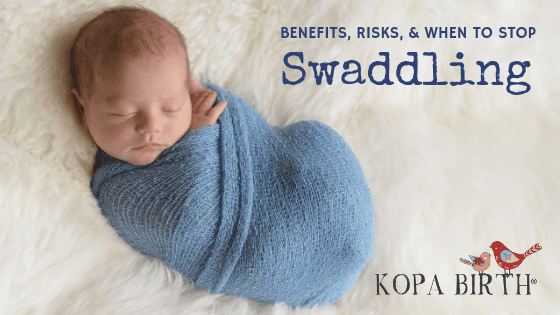
Estimated reading time: 7 minutes
As a new parent trying to comfort your crying baby, the calming effect of swaddling feels like a tool handed down from heaven. So what are the benefits of swaddling? Are there risks? And how long are we able to wrap up our sweet babies like little burritos? How do you know when to stop swaddling?
Swaddling has a wide variety of benefits for your baby. In addition to providing comfort, swaddling can encourage newborn sleeping and helps babies sleep longer. It can help regulate baby’s body temperature. And swaddling can improve neuromuscular and motor development. Swaddling is a natural way to help transition your precious newborn from the close comfort of the womb to the outside world.
Although swaddling can be an amazing help, there are some things to keep in mind:
Remember, while swaddling can be soothing, it’s not necessary for all babies. If your baby seems unhappy being swaddled or consistently breaks free of the swaddle, they may sleep better without it. Always monitor your baby while they are swaddled to ensure they are comfortable, not overheating, and breathing easily.
One of the biggest challenges of parenting is that once we get the hang of something, it’s usually time to change things up! Unfortunately, this is true of swaddling, too. It may surprise you to learn that you should stop swaddling at around 8 weeks.
Why stop swaddling so early? 8 weeks is generally the age right before your baby starts to become more active and self-aware. Soon he’ll start to wiggle, roll, and turn over. Turning over while swaddled is dangerous because it places your baby at a risk of smothering. So, it makes sense to transition out of swaddling well before your baby has the ability to roll. While 8 weeks is a general guideline, it may be even sooner if your baby shows signs of possibly turning over before then (3).
The good news is that 8 weeks is just about the same time that babies lose the startle or Moro reflex. This makes them less jumpy, better able to regulate their bodies, and less likely to wake themselves from a good sleep. The loss of this reflex decreases the need for swaddling.
If you haven’t already, begin to establish a nighttime routine in the weeks before swaddling comes to an end. One way to help this transition is to put your baby down while they are still awake but drowsy. Do this as early on in their life as possible. These types of routines will make it a little easier as you begin to place baby down to sleep without swaddling.
And one last tip. Make sure to take as many pictures as possible, because seriously, a swaddled baby is just pure adorableness.
Kopa Birth’s online childbirth classes allow you to prepare for a natural childbirth from the comfort of your own home, 24/7. Enroll today in our free online childbirth class to learn more about preparing for a natural hospital birth.
References:
1) Van Sleuwen, B. E., Engelberts, A, C., Boere-Boonekamp, M. M., Kuis, W., Schulpen,T.W.J., L’Hoir, M.P. Swaddling: a Systematic Review. Retrieved at http://pediatrics.aappublications.org/content/120/4/e1097
2) Moon, R. Y. (2013). How to Keep Your Sleeping Baby Safe: AAP Policy Explained By: Rachel Y. Moon. Retrieved at http://www.aappublications.org/content/34/6/34
3) Kennedy, K. (2013). Unwrapping the Controversy Over Swaddling. Retrieved at http://www.aappublications.org/content/34/6/34
As a new parent trying to comfort your crying baby, the calming effect of swaddling feels like a tool handed down from heaven. So what are the benefits of swaddling?